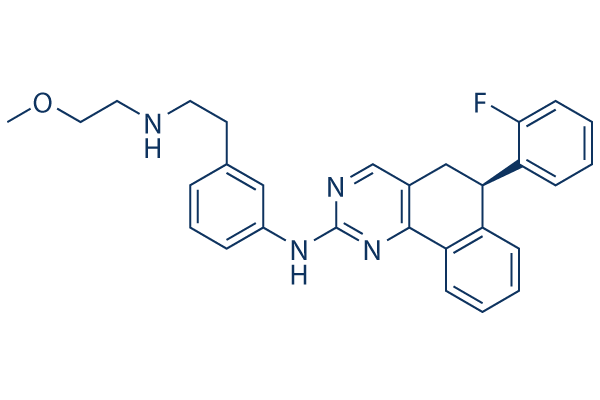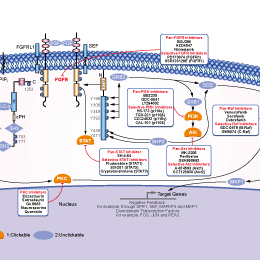
- Bioactive Compounds
- By Signaling Pathways
- PI3K/Akt/mTOR
- Epigenetics
- Methylation
- Immunology & Inflammation
- Protein Tyrosine Kinase
- Angiogenesis
- Apoptosis
- Autophagy
- ER stress & UPR
- JAK/STAT
- MAPK
- Cytoskeletal Signaling
- Cell Cycle
- TGF-beta/Smad
- DNA Damage/DNA Repair
- Compound Libraries
- Popular Compound Libraries
- Customize Library
- Clinical and FDA-approved Related
- Bioactive Compound Libraries
- Inhibitor Related
- Natural Product Related
- Metabolism Related
- Cell Death Related
- By Signaling Pathway
- By Disease
- Anti-infection and Antiviral Related
- Neuronal and Immunology Related
- Fragment and Covalent Related
- FDA-approved Drug Library
- FDA-approved & Passed Phase I Drug Library
- Preclinical/Clinical Compound Library
- Bioactive Compound Library-I
- Bioactive Compound Library-Ⅱ
- Kinase Inhibitor Library
- Express-Pick Library
- Natural Product Library
- Human Endogenous Metabolite Compound Library
- Alkaloid Compound LibraryNew
- Angiogenesis Related compound Library
- Anti-Aging Compound Library
- Anti-alzheimer Disease Compound Library
- Antibiotics compound Library
- Anti-cancer Compound Library
- Anti-cancer Compound Library-Ⅱ
- Anti-cancer Metabolism Compound Library
- Anti-Cardiovascular Disease Compound Library
- Anti-diabetic Compound Library
- Anti-infection Compound Library
- Antioxidant Compound Library
- Anti-parasitic Compound Library
- Antiviral Compound Library
- Apoptosis Compound Library
- Autophagy Compound Library
- Calcium Channel Blocker LibraryNew
- Cambridge Cancer Compound Library
- Carbohydrate Metabolism Compound LibraryNew
- Cell Cycle compound library
- CNS-Penetrant Compound Library
- Covalent Inhibitor Library
- Cytokine Inhibitor LibraryNew
- Cytoskeletal Signaling Pathway Compound Library
- DNA Damage/DNA Repair compound Library
- Drug-like Compound Library
- Endoplasmic Reticulum Stress Compound Library
- Epigenetics Compound Library
- Exosome Secretion Related Compound LibraryNew
- FDA-approved Anticancer Drug LibraryNew
- Ferroptosis Compound Library
- Flavonoid Compound Library
- Fragment Library
- Glutamine Metabolism Compound Library
- Glycolysis Compound Library
- GPCR Compound Library
- Gut Microbial Metabolite Library
- HIF-1 Signaling Pathway Compound Library
- Highly Selective Inhibitor Library
- Histone modification compound library
- HTS Library for Drug Discovery
- Human Hormone Related Compound LibraryNew
- Human Transcription Factor Compound LibraryNew
- Immunology/Inflammation Compound Library
- Inhibitor Library
- Ion Channel Ligand Library
- JAK/STAT compound library
- Lipid Metabolism Compound LibraryNew
- Macrocyclic Compound Library
- MAPK Inhibitor Library
- Medicine Food Homology Compound Library
- Metabolism Compound Library
- Methylation Compound Library
- Mouse Metabolite Compound LibraryNew
- Natural Organic Compound Library
- Neuronal Signaling Compound Library
- NF-κB Signaling Compound Library
- Nucleoside Analogue Library
- Obesity Compound Library
- Oxidative Stress Compound LibraryNew
- Plant Extract Library
- Phenotypic Screening Library
- PI3K/Akt Inhibitor Library
- Protease Inhibitor Library
- Protein-protein Interaction Inhibitor Library
- Pyroptosis Compound Library
- Small Molecule Immuno-Oncology Compound Library
- Mitochondria-Targeted Compound LibraryNew
- Stem Cell Differentiation Compound LibraryNew
- Stem Cell Signaling Compound Library
- Natural Phenol Compound LibraryNew
- Natural Terpenoid Compound LibraryNew
- TGF-beta/Smad compound library
- Traditional Chinese Medicine Library
- Tyrosine Kinase Inhibitor Library
- Ubiquitination Compound Library
-
Cherry Picking
You can personalize your library with chemicals from within Selleck's inventory. Build the right library for your research endeavors by choosing from compounds in all of our available libraries.
Please contact us at info@selleckchem.com to customize your library.
You could select:
- Antibodies
- Bioreagents
- qPCR
- 2x SYBR Green qPCR Master Mix
- 2x SYBR Green qPCR Master Mix(Low ROX)
- 2x SYBR Green qPCR Master Mix(High ROX)
- Protein Assay
- Protein A/G Magnetic Beads for IP
- Anti-Flag magnetic beads
- Anti-Flag Affinity Gel
- Anti-Myc magnetic beads
- Anti-HA magnetic beads
- Poly DYKDDDDK Tag Peptide lyophilized powder
- Protease Inhibitor Cocktail
- Protease Inhibitor Cocktail (EDTA-Free, 100X in DMSO)
- Phosphatase Inhibitor Cocktail (2 Tubes, 100X)
- Cell Biology
- Cell Counting Kit-8 (CCK-8)
- Animal Experiment
- Mouse Direct PCR Kit (For Genotyping)
- New Products
- Contact Us
research use only
Derazantinib FGFR inhibitor
Derazantinib is an orally bioavailable inhibitor of the fibroblast growth factor receptor (FGFR) with IC50 values of 1.8 nM for FGFR2, and 4.5 nM for FGFR1 and 3, showing lower potency for FGFR4 (IC50=34 nM). It also inhibits RET, DDR2, PDGFRβ, VEGFR and KIT.

Chemical Structure
Molecular Weight: 468.57
Purity & Quality Control
Batch:
Purity:
99.91%
99.91
Related Products
| Related Targets | FGFR1 FGFR2 FGFR3 FGFR4 | Click to Expand |
|---|---|---|
| Related Products | Fexagratinib (AZD4547) PD173074 BLU9931 LY2874455 Zoligratinib (Debio-1347) Futibatinib (TAS-120) PD-166866 SSR128129E H3B-6527 Fisogatinib (BLU-554) FIIN-2 Ferulic Acid ASP5878 Roblitinib (FGF401) Alofanib (RPT835) NSC12 PRN1371 | Click to Expand |
| Related Compound Libraries | Kinase Inhibitor Library Tyrosine Kinase Inhibitor Library PI3K/Akt Inhibitor Library Cell Cycle compound library Angiogenesis Related compound Library | Click to Expand |
Signaling Pathway
Mechanism of Action
| Targets |
|
|---|
In vitro |
||||
| In vitro | ARQ-087 has anti-proliferative activity in cell lines driven by FGFR dysregulation, including amplifications, fusions, and mutations. Cell cycle studies in cell lines with high levels of FGFR2 protein show a positive relationship between ARQ 087 induced G1 cell cycle arrest and subsequent induction of apoptosis. ARQ 087 inhibits the auto-phosphorylation of FGFR1 and FGFR2 in a dose-dependent manner. In Cos-1 cells overexpressing full-length FGFR1, FGFR2, FGFR3 and FGFR4, ARQ 087 inhibits their phosphorylation with EC50 values of < 0.123 μM, 0.185 μM, 0.463 μM, >10 μM respectively. ARQ 087 inhibits FGFR kinase by an ATP competitive mechanism, and is capable of inhibiting both the inactive and fully active forms of the FGFR kinase. Hence, ARQ 087 delays FGFR activation by inhibiting its autophosphorylation, as well as inhibition of the phosphorylated active kinase[1]. |
|||
|---|---|---|---|---|
| Kinase Assay | Determination of Ki and mode of inhibition | |||
| Kinase inhibitory activity of ARQ 087 was determined for the recombinant FGFR1 or FGFR2 proteins utilizing a biotinylated PYK2 peptide substrate and ATP. ARQ 087 was titrated in DMSO utilizing a 3-fold dilution scheme, and then diluted 10-fold further in deionized water for a final DMSO concentration of 10%. A volume (2.5 μL) of these dilutions or vehicle was added to each well of a reaction plate. FGFR1 or FGFR2 was added to assay buffer (50 mM Tris, pH 8.0, 0.02 mg/mL BSA, 10 mM MgCl2, 1 mM EGTA, 10% glycerol, 0.1 mM Na3PO4, 1 mM DTT) to each well in a volume of 17.5 μL for a final concentration of 0.50 or 0.25 nM, respectively. After a 30-minute pre-incubation period, ATP and substrate were added in assay buffer (5 μL) for final concentrations of 0–1,000 μM ATP and 80 nM biotinylated-PYK2, for a final reaction volume of 25 μL. The plates were incubated for 60 minutes at room temperature, and then stopped in the dark by the addition of 10 μL stop/detection mixture prepared in assay buffer containing EDTA, AlphaScreen™ Streptavidin Donor and P-TYR-100 Acceptor beads for final concentrations of 10 mM EDTA and 500 ng/well of both AlphaScreen™ Donor and Acceptor beads. Assay plates were incubated for 60 minutes at room temperature in the dark, and the plates were read on a Perkin Elmer, Envision Multilabel plate reader. (excitation wavelength: 640 nm, emission wavelength: 570 nm). The effect of enzyme concentration was applied for tight-binding inhibitors, and if necessary, the IC50 values were converted into Ki values if the enzyme concentration was above the IC50 values under the assay conditions utilized. | ||||
| Cell Research | Cell lines | NCI-H716 and SNU-16 cells | ||
| Concentrations | 0.1 μM or 1 μM | |||
| Incubation Time | 24 or 72 hours | |||
| Method | Cells are plated and incubated at 37°C overnight and subsequently treated with 0.1 μM or 1 μM of ARQ 087 for 24 or 72 hours. The cells were fixed and stained with Cycletest Plus Reagent kit and cell cycle profiles were analyzed using a FACS Calibur flow cytometer. |
|||
In Vivo |
||
| In vivo | ARQ 087 attenuates FGFR signaling in SNU-16 human xenograft tumors, leading to a reduction in phospho-FGFR, phospho-FRS2-α, and phospho-ERK, while the total FGFR2 protein is unaffecte. ARQ 087 is effective at inhibiting tumor growth in vivo in FGFR2 altered, SNU-16 and NCI-H716, xenograft tumor models with gene amplifications and fusions. ARQ 087 demonstrated efficacy in multiple in vivo xenograft models, and was well tolerated at doses up to 75 mg/kg[1]. |
|
|---|---|---|
| Animal Research | Animal Models | female NCr nu/nu mice (SNU-16) or CB17 SCID mice (NCI-H716) |
| Dosages | 0, 25, 50, and 75 mg/kg | |
| Administration | oral administration | |
References |
|
Chemical Information
| Molecular Weight | 468.57 | Formula | C29H29FN4O |
| CAS No. | 1234356-69-4 | SDF | -- |
| Synonyms | ARQ-087 | ||
| Smiles | COCCNCCC1=CC(=CC=C1)NC2=NC=C3CC(C4=CC=CC=C4C3=N2)C5=CC=CC=C5F | ||
Storage and Stability
| Storage (From the date of receipt) | 3 years -20°C powder | ||
|
In vitro |
DMSO : 93 mg/mL ( (198.47 mM) Moisture-absorbing DMSO reduces solubility. Please use fresh DMSO.) Water : Insoluble Ethanol : Insoluble |
Molecular Weight Calculator |
|
In vivo Add solvents to the product individually and in order. |
In vivo Formulation Calculator |
|||||
Preparing Stock Solutions
Molarity Calculator
In vivo Formulation Calculator (Clear solution)
Step 1: Enter information below (Recommended: An additional animal making an allowance for loss during the experiment)
mg/kg
g
μL
Step 2: Enter the in vivo formulation (This is only the calculator, not formulation. Please contact us first if there is no in vivo formulation at the solubility Section.)
% DMSO
%
% Tween 80
% ddH2O
%DMSO
%
Calculation results:
Working concentration: mg/ml;
Method for preparing DMSO master liquid: mg drug pre-dissolved in μL DMSO ( Master liquid concentration mg/mL, Please contact us first if the concentration exceeds the DMSO solubility of the batch of drug. )
Method for preparing in vivo formulation: Take μL DMSO master liquid, next addμL PEG300, mix and clarify, next addμL Tween 80, mix and clarify, next add μL ddH2O, mix and clarify.
Method for preparing in vivo formulation: Take μL DMSO master liquid, next add μL Corn oil, mix and clarify.
Note: 1. Please make sure the liquid is clear before adding the next solvent.
2. Be sure to add the solvent(s) in order. You must ensure that the solution obtained, in the previous addition, is a clear solution before proceeding to add the next solvent. Physical methods such
as vortex, ultrasound or hot water bath can be used to aid dissolving.
Tech Support
Answers to questions you may have can be found in the inhibitor handling instructions. Topics include how to prepare stock solutions, how to store inhibitors, and issues that need special attention for cell-based assays and animal experiments.
Tel: +1-832-582-8158 Ext:3
If you have any other enquiries, please leave a message.
* Indicates a Required Field






































